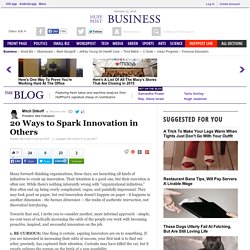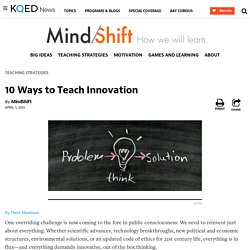

20 Ways to Spark Innovation in Others Many forward-thinking organizations, these days, are launching all kinds of initiatives to crank up innovation.

Their intention is a good one, but their execution is often not. While there's nothing inherently wrong with "organizational initiatives," they often end up being overly complicated, vague, and painfully impersonal. They may look good on paper, but real innovation doesn't happen on paper - it happens in another dimension - the human dimension -- the realm of authentic interaction, not theoretical interfacing. Towards that end, I invite you to consider another, more informal approach - simple, no-cost ways of radically increasing the odds of the people you work with becoming proactive, inspired, and successful innovators on the job. 1. 2. 3. 4. 5. 6. 7. 8. 10. 12. 13. 14. 16. 17. 18.
Google X Head on Moonshots: 10X Is Easier Than 10 Percent. Here is the surprising truth: It’s often easier to make something 10 times better than it is to make it 10 percent better.

Yes … really. Because when you’re working to make things 10 percent better, you inevitably focus on the existing tools and assumptions, and on building on top of an existing solution that many people have already spent a lot of time thinking about. Such incremental progress is driven by extra effort, extra money, and extra resources. It’s tempting to feel improving things this way means we’re being good soldiers, with the grit and perseverance to continue where others may have failed — but most of the time we find ourselves stuck in the same old slog. But when you aim for a 10x gain, you lean instead on bravery and creativity — the kind that, literally and metaphorically, can put a man on the moon. And that, counter-intuitively, makes the hardest things much easier to accomplish than you might think. Just Crazy Enough Not all moonshots have to be about technology. Sir Ken Robinson - Can Creativity Be Taught? 4 Steps to Becoming a Maker Teacher - Getting Smart by Guest Author - deeper learning, maker, makered, teachers.
By: Gayle Allen and Lisa Yokana The Maker Movement has become a global phenomenon.

In 2013, nearly 100 Mini and Featured Maker Faires took place in cities like, Oslo, Rome, Santiago and Tokyo, with Maker Faires held in New York City and the San Francisco Bay setting attendance records. The work of educational researchers supports educators’ belief in the power of making for student learning, such as embodied cognition, deep learning, spatial-reasoning skills, creative confidence and 21st Century skills. The result? Schools around the country are converting classrooms and even buildings into makerspaces and innovation labs.
So imagine how surprised many educators are when students resist making in the classroom. 4 Stages of Making Making and creating can be challenging. Stage 1: Getting Started Kick off the process by sharing an open-ended assignment and the resources available to complete it. Student: “I have no idea where to start.” 10 Ways to Teach Innovation. Getty By Thom Markham One overriding challenge is now coming to the fore in public consciousness: We need to reinvent just about everything.

Where Good Ideas Come From & How Your Classroom Can Respond. Where Good Ideas Come From & How Your Classroom Can Respond The source for innovative or creative thinking is as much as mystery as that of curiosity or particular genius.

In a traditional classroom, “having a good idea” is strangely not valued as much as the ability to demonstrate proficiency with a specific assessment form. In fact, “good ideas” can often be disruptive to a tightly-sequenced and outcomes-based learning process. This is curious for a number of reasons, among them the reality that creative solutions and “good ideas” are the result of an artistic mingling of all that is right with learning, including: The identification of a problem or opportunityAn awareness of potential resources and previous modelsThe interdependence of people, technology, past experience, and collectively-wrought social goalsThe iteration of thinking that leads to a solution or further important thinking “Chance favors a connected mind.” 5 Takeaways For Your Classroom.
Catalysts for Curiosity and Creativity. This post is based on an Ignite talk I gave at the Learning at Schools Unconference at Sky City at the end of January. Titled Catalysts for Curiosity and Creativity, in 5 minutes I briefly covered some suggestions for how teachers can enable students to unleash their creativity. Many of the ideas stem from 2 amazing books I read over summer: Can Computers Keep Secrets by Tom Barrett (from NoTosh) and Creative Confidence by Tom & David Kelley (of IDEO fame). I highly recommend reading both of these books! When someone mentions curiosity to me, I think of: a sense of childlike wondereyes wide openlooking for new ideas to identify and explore For me, I link this very closely with creativity. We forget that back in Kindergarten we were all creative.Creative Confidence location 168 Kindle edition.
My daughter’s artwork – age 3 1/2 Curiosity and Creativity are so important and so linked for me that form 2 of my most core educational values: